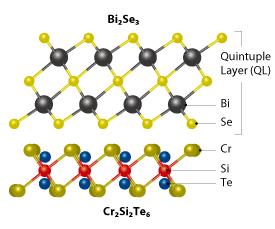

11/30/2020

Modified from Ref. 1 and licensed under CC-BY © 2020 T. Kato et al.
Growing a material known as a topological insulator on a ferromagnet could open the way to create various exotic quantum effects in the topological insulator, AIMR researchers have shown1. This structure could be used in spintronic applications for converting between spin and charge currents.
Topological insulators have generated a huge amount of interest since their discovery in 2007. Their most well-known property is their ability to conduct electricity along their surfaces while being electrically insulating inside.
Although topological insulators are interesting in their own right and promising for applications in the area of spintronics, even more exotic quantum effects could be induced in them if were possible to create an energy gap known as the Dirac gap. One way to do this is to introduce magnetic impurities into a topological insulator, but this creates defects in the material and can be used only at low temperatures.
Now, Takafumi Sato of the AIMR at Tohoku University and his co-workers have demonstrated a new strategy to create a Dirac gap in a topological insulator. They grew ultrathin films of a topological insulator on a ferromagnet and observed a Dirac gap when the topological insulator was about 2 nanometers thick (see image).
This Dirac gap was induced by an effect known as interfacial coupling, whereby the ferromagnetism of the magnetic layer influences the electron states on the surface of the topological insulator. “Our result suggests that interfacial coupling, which had not been considered much in previous studies, is crucial for controlling Dirac fermions in heterostructure systems involving a topological insulator,” says Sato. “This will help toward realizing exotic topological phenomena and device applications of topological insulators.”
The team hadn’t expected the effect to be so strong. “Before doing the experiment, we thought that interfacial coupling would modulate the Dirac cone only by a very small amount,” says Sato. “However, to our surprise, the interfacial coupling turned out to alter the overall band dispersion of the Dirac-cone surface states when the topological insulator film was thin enough.”
Fabricating high-quality topological insulator thin films on the ferromagnet was challenging, but the team succeeded thanks to state-of-the-art techniques and helpful collaborators. “Critical to our successful film growth was a sophisticated molecular-beam-epitaxy technique developed in our laboratory and high-quality single crystals provided by Eiji Saitoh’s team,” says Sato.
The team now intends to explore different combinations of topological insulators and ferromagnets in order to enhance the ferromagnetic proximity.
This research highlight has been approved by the authors of the original article and all information and data contained within has been provided by said authors.